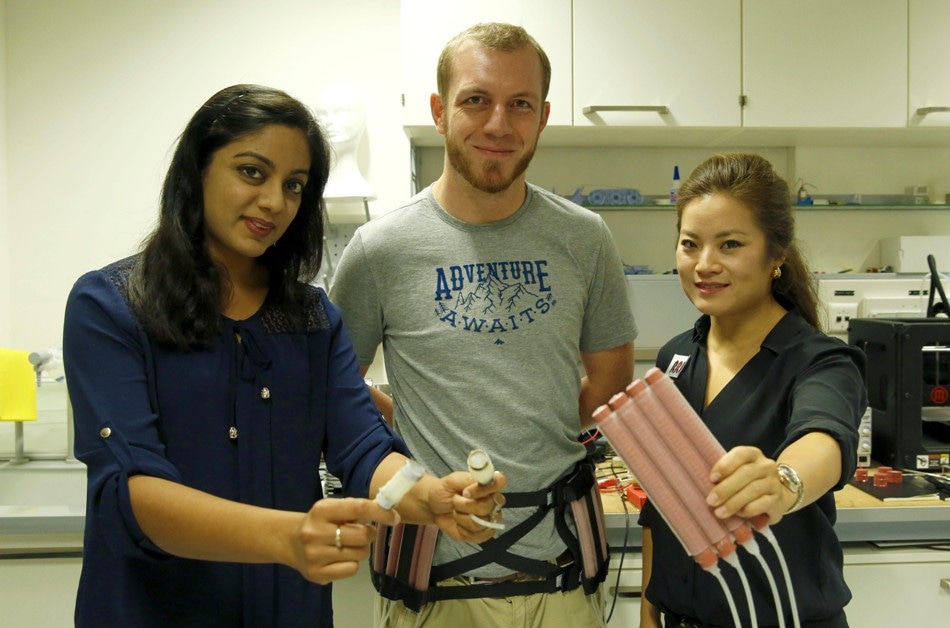Oct 13 2016
 Gunjan Agarwal, Matthew Robertson and Jamie Paik © Marc Delachaux/2016 EPFL
Gunjan Agarwal, Matthew Robertson and Jamie Paik © Marc Delachaux/2016 EPFL
Robots that are soft, flexible and reconfigurable are being built by EPFL researchers. The robots are air-actuated and act like human muscles, and could be applied in physical rehabilitation. They are made of inexpensive materials and could easily be mass produced.
These new robots are unique as they go against the conventional expectation that robots are meant to be fast, rigid, and efficient. The team that created the soft robots are from EPFL’s Reconfigurable Robotics Lab (RRL).
The soft robots are powered by muscle-like actuators, and are meant to be used on the human body to help people move. They are composed of elastomers, including rubber and silicon, so they are innately safe. They are manipulated by modifying the air pressure in specially designed ‘soft balloons’, which also act as the body of the robot.
Details of a predictive model for careful manipulation of the mechanical behavior of the robots’ varied modules has been published in Nature - Scientific Reports recently.
Probable applications for these robots include patient rehabilitation, biomimetic systems, handling fragile objects, and home care.
Our robot designs focus largely on safety. There’s very little risk of getting hurt if you're wearing an exoskeleton made up of soft materials, for example.
Jamie Paik, Director, RRL
A Model to Control the Actuators
The researchers demonstrated that their model could correctly predict the way a series of modules moves. The modules are made up of compartments and sandwiched chambers. The cucumber-shaped actuators can expand to roughly five or six times their normal length and bend in two directions, based on the model.
We conducted numerous simulations and developed a model for predicting how the actuators deform as a function of their shape, thickness and the materials they’re made of.
Gunjan Agarwal, Lead Author
One variant consists of the actuator covered in a thick paper shell created using origami. This test indicated that various materials could be used.
“Elastomer structures are highly resilient but difficult to control. We need to be able to predict how, and in which direction, they deform. And because these soft robots are easy to produce but difficult to model, our step-by-step design tools are now available online for roboticists and students.”
A Rehabilitation Belt
In addition to these simulations, other RRL researchers have created soft robots for medical applications. Their work is illustrated in Soft Robotics. One of their designs includes a belt composed of many inflatable parts, which holds patients erect during rehabilitation exercises and directs their movements.
We are working with physical therapists from the University Hospital of Lausanne (CHUV) who are treating stroke victims. The belt is designed to support the patient’s torso and restore some of the person’s motor sensitivity.
Matthew Robertson, Researcher
The soft actuators of the belt are created using pink rubber and transparent fishing line. The placement of the fishing line directs the deformation of the modules very precisely when air is injected. “For now, the belt is hooked up to a system of external pumps. The next step will be to miniaturize this system and put it directly on the belt,” said Robertson.
Adaptable and Reconfigurable Robots
Potential applications for soft actuators can go beyond this. The researchers are also using them to build adaptable robots with the capability to navigate around in confined, hostile environments. Since they are totally soft, they would also possess the ability to withstand crushing and squeezing.
Using soft actuators, we can come up with robots of various shapes that can move around in diverse environments. They are made of inexpensive materials, and so they could easily be produced on a large scale. This will open new doors in the field of robotics.
Jamie Paik, Director, RRL
Soft robots that mimic human muscles
Credit: EPFL